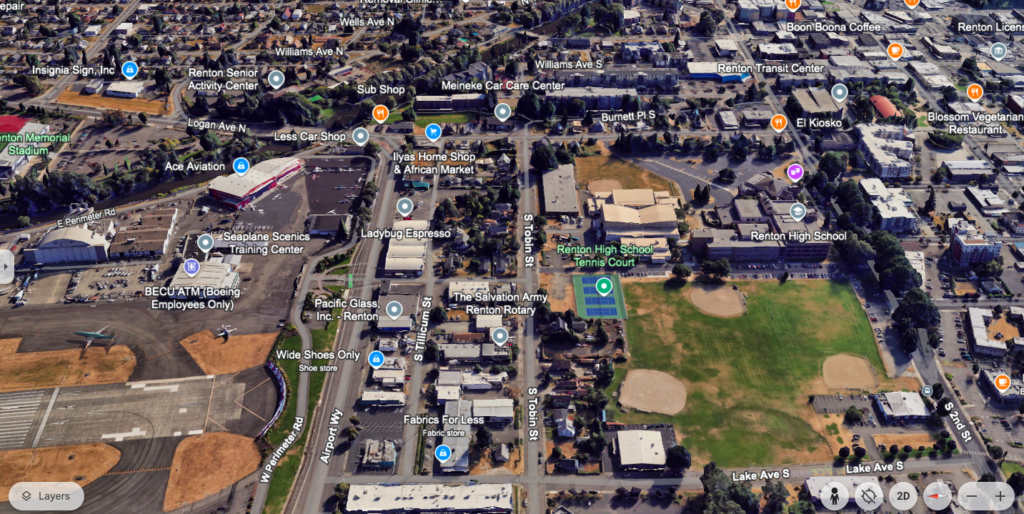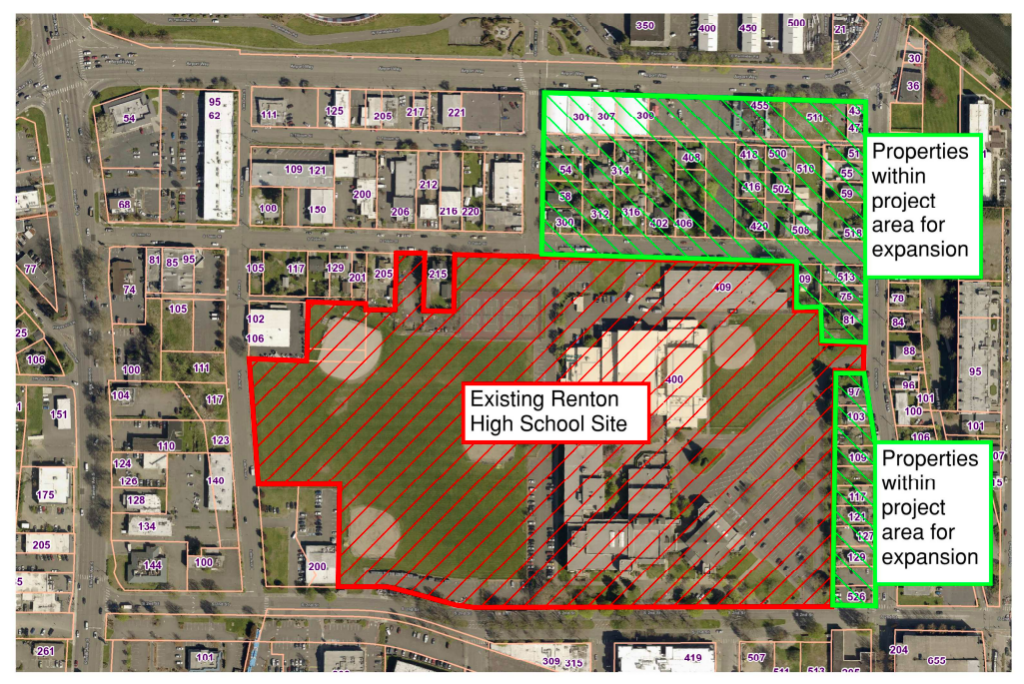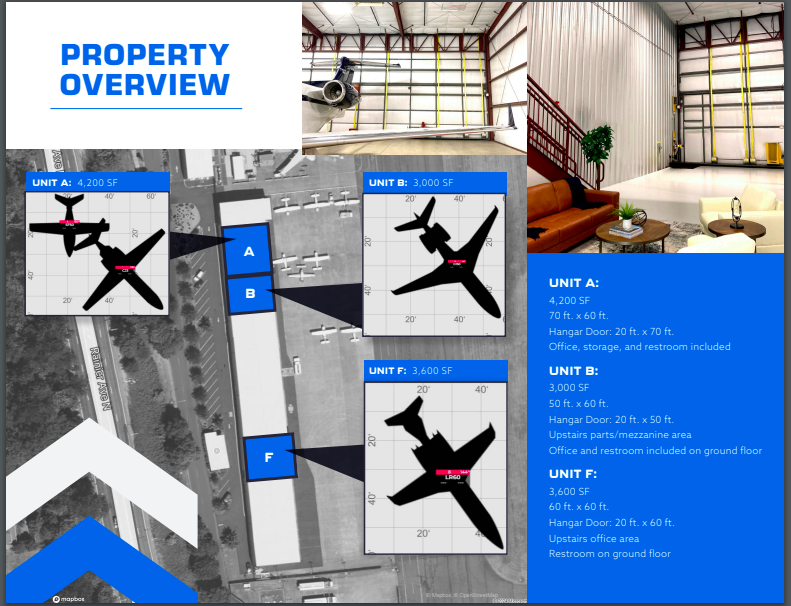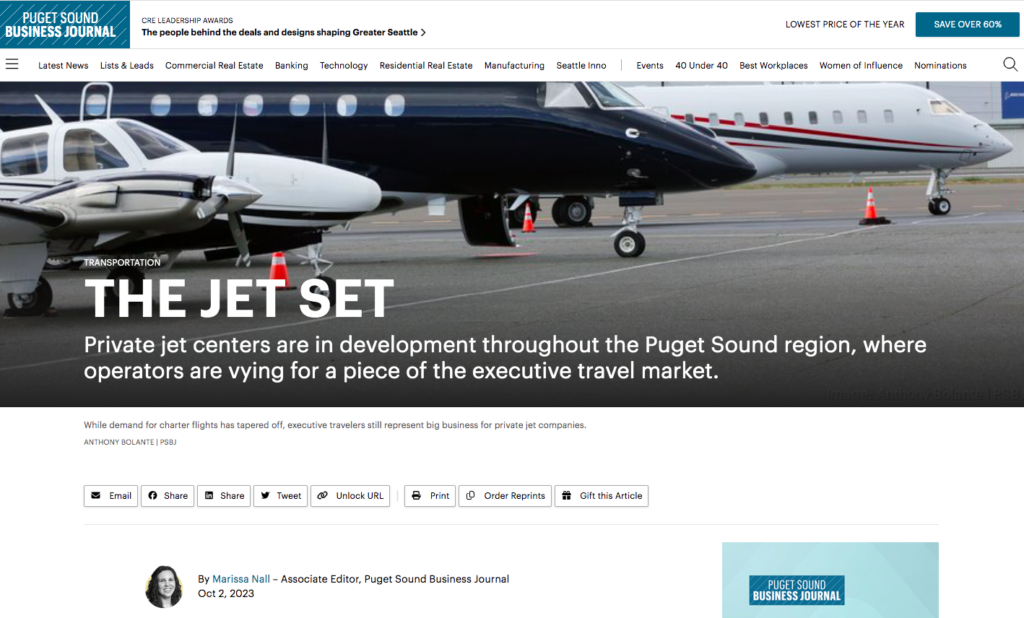
An extension of Renton airport (left) would put the runway and taxiway right into Renton High School (right), which is about to undergo a half-billion dollar rebuild.
In 2020 the City of Renton worked diligently with the FAA to avoid an airport reclassification which would have required Renton to extend our runway and taxiway one-thousand feet into Renton High School and the nearby homes and businesses. The arguments Renton made to avoid the extension leaned heavily on the fact that almost all our air traffic was lightweight propeller aircraft with just one or two carefully-orchestrated new 737 takeoffs per day. We barely prevailed….if the jet operations had been any more numerous, we would have needed to extend the airport into the neighborhood and school.
Today, to the dismay of impacted residents, Renton School District is purchasing and/or condemning much of the same neighborhood property that we protected in 2020, in order to amass land for a half-billion dollar rebuild of Renton High School. (The average Renton household will pay about $1000 per year in additional property tax for 22 years to fund this rebuild.)

The School District is acquiring the properties shown in green to add to existing Renton High campus. If the airport were extended, much of this property would be in the taxiway, and/or the runway safety “object-free” area.
This use of eminent domain is already controversial. But even more confounding, Renton Airport management (overseen by the Public Works Administrator) is aggressively driving out small aircraft and replacing them with jets, which could soon put the airport in need of the same property the School District plans to build on.

After many years of thriving, The Landing Gear Works was pushed from Renton Airport last year. Renton also lost two large popular flight schools and two seaplane-related businesses.
In the past year our airport lost two locally-owned flight schools, a small airplane parts manufacturer, an amphibious airplane design engineering office, and a seaplane operator. Our new tenant is Dark Horse Aviation, who self-identify on their website as “a vertically integrated real estate private equity firm focussed on business-aviation hangar acquisitions and development.” They feature a business jet in their banner.
Past Renton councils could have rented to business jet operators at any time– there was always a long line of jet owners looking for space who would have pumped millions of dollars into the airport. But we made our airport support our Renton City mission of making our city a place where people choose to live, work, learn and play. We support our mission with flight schools for Renton’s aspiring young pilots, seaplane charters, and airplane manufacturing– not with private jet hangars for affluent out-of-town residents.
With our limited 5300-foot field length, Renton must be very careful not to encourage medium to large jet traffic. In Dark Horse Aviation’s marketing materials for their Pro-flight hangers, they show a notional graphic of a Learjet 60 business jet (along with other jets) in their new space. Just one jet of this Learjet 60 category, operating five flights a week out of Renton, could trigger an FAA airport reclassification from B to C (similar to the B to D reclassification we almost had from the Boeing delivery ramp-up in 2019) requiring an extension of our runway of approximately 700-800 feet. Unless the state, tribes, and other stakeholders somehow allow Renton to infill a quarter-million square feet of Lake Washington (unlikely), the new taxiway would occupy the same neighborhood property that Renton School District is currently acquiring to build the $500,000,000 new high school. (Note the Learjet 60 is a slightly longer version of the Learjet 55 that crashed in Philadelphia this past week, killing 7 and injuring 22.)

Darkhorse Aviation leasing materials show a possible Learjet 60 in Unit F. One of these aircraft making one takeoff and landing each weekday could push Renton’s runway into a longer category.
Encouraging private jet use is also counter to Renton’s climate and carbon goals. A traveler who flies on a private jet generates about ten times as much carbon as if they flew commercially, or drove a car, or flew in a light prop plane.
And these private jets land and takeoff at about 120-140 miles per hour, leaving only a few seconds of safety margin on a 5300 foot runway, while four-seat propeller planes takeoff at about 40 mph.
The Santa Monica Airport vividly illustrates the conflicts that lie ahead for Renton. The airport is like a sister to Renton, once home to McDonnell Douglas manufacturing and light planes, and then increasingly utilized by business jets. Ten years ago (10/28/14) The New York Times ran a story about Santa Monica titled “the noise near this airport is getting louder,” The lengthy story can be summarized by this quote: “The issue is, this used to be a small airport that didn’t have jets, and people managed to get along,” said John Fairweather, the leader of one of several groups that want either a reduction in jet traffic or closure of the airport.” Renton’s current Public Works Director, who was coincidently then-employed by Santa Monica and overseeing Santa Monica Airport at that time, was also quoted in the story. “You’ve got a greater and greater density” in population, said Martin Pastucha, Santa Monica’s director of public works. “The use of the airport at its inception is a different environment than what it is currently, and you have to ask, ‘Are those two compatible anymore?’ ”
But unlike Renton airport which was previously owned by the Federal Government, Santa Monica started as a private airport, giving residents more control of Santa Monica airport. And infuriated residents began to push on their Council and Mayor to close the airport to get rid of the jet noise. They’ve now shortened their runway, and are considering closing the airport in the coming years. The airport is a primary issue each Santa Monica council member now runs on every election, even while the city faces similar challenges to Renton with housing costs, homelessness, drugs, and other issues.
Our airport’s history and on-going commitments to FAA would not allow Renton to close our airport, even if we wanted to. The only way to keep the runway from colliding with Renton High School, and to avoid Santa Monica’s fate is for Renton Council to carefully deliberate over every lease it agrees to, to ensure that new aviation tenants are performing aviation services that engage our residents and support our city mission statement. The Renton Airport Advisory Committee (RAAC) was charted twenty years ago to oversee this critical work, providing both professional aviation expertise (free of charge) and up-to-date neighborhood perspectives; but this committee’s capabilities have been unreasonably diminished and under-utilized in recent years. While I was on council, with the co-leadership of RAAC, we created an Airport Sustainability plan using an FAA grant that provides a blueprint that could help the council accomplish this important chore.
Wealthy individuals are looking for private jet space. But Renton did not have to give up our flight schools and small parts manufacturer to make way for them. Council should push back on these decisions.




It’s ironic to look at the current Renton Reporter (January 30, 2025) with the first story “Renton Family’s fight for land justice continues with new bill” about the John Wayne Houston family losing their home to the Renton School District eminent domain in the 1960’s, over the next article: “Board approves schematic designs for Renton High School” which takes more homes by eminent domain today!
Glad your writing again. This two has a lot of problems that nobody wants to talk about.
I’ve shared this blog post on Facebook and Nextdoor, and been asked good questions. I will share some of the questions and answers here:
Question: Why does the runway need to be lengthened? Boeing hasn’t suffered any hull losses where they couldn’t take off in time and dipped into the lake, have they? The only planes they ever built there were the 707, the 727, the 737 and the 757 and all of those planes easily were able to take off from Renton Airport.
My Answer:
That is a great question, and I’m sure others are wondering the same thing. The FAA requires an airport to be extended when the number of operations of a class of airplanes exceeds five-hundred in a year. Boeing was projecting deliveries to exceed this number in 2019, before the pandemic and the MAX crashes. Based on the 2019 number, the FAA was going to enforce the need for a runway extension. After Boeing production dropped, the FAA backed off on the need to extend the runway, for now.
A loaded Learjet 60 needs as much runway to land and takeoff as a nearly empty 737, so these private jet activities could push us back over the threshold, even with lower Boeing deliveries.
Boeing also takes many other protections for their jet operations. New engines for max thrust, new tires and brakes for a quick stop if something goes wrong, everything on the airplane tested in advance, delay flight if it is too icy or too warm, and a fire engine always on standby just in case.
This is why adding private jets to the airport puts the length of the runway in doubt even with the current number of Boeing deliveries already being acceptable.
_______________________
Question:
I was at the Renton Municipal Airport Advisory committee meeting right before the first 737 crashed that halted everything. The FAA person said at the meeting that the new rules expanding the Airport were a suggestion and not mandatory.
My Answer:
Yes, this was what we had hoped/thought at the time of the last RAAC meeting before the pandemic. Then RAAC stopped meeting. Some RAAC members that were aviation professionals continued working with the city to further sort out the issue, and ultimately the city hired an aviation attorney with some airport business contributing to the cost.
While we initially tried leaning on the FAA’s guidance being an “Advisory Circular,” (AC) the FAA reminded us that any approach that was different than their AC would need to offer equivalent safety to the AC. They held firm that 500 operations was a tipping point, and did not seem significantly persuaded by our arguments surrounding the safety precautions Boeing takes. Ultimately we won the day because of the Boeing revised delivery numbers.
The FAA’s position is a sensible one, that’s easiest to understand by studying the concept of the “the balanced field length.” When a multi-engine airplane is taking off, there needs to be enough runway length that if one engine quits at the worst possible moment, there is enough field length left to either take-off with the remaining engine or to stop without overrunning the runway plus a two second pilot reaction time.
For fully-loaded 737s or Learjet 60 airplanes, Renton is not long enough to provide a balanced field length. The runway IS long enough to provide a balanced field length for these airplanes when they are partially loaded on days when the runway is not wet and the air is reasonably dense (not too hot). So these airplanes can operate out of Renton for many conditions, but not all conditions. This means operators of these aircraft will need to carefully calculate their decision point, and they’ll operate with only a second or two of margin for every takeoff. FAA will accept such takeoffs on an occasional basis, but they do not see this as acceptable for a design condition. Any miscalculation could end in disaster.
So, FAA says if one airplane in this category is taking off and landing per weekday, or 500 operations per year, then the field must be lengthened.
There is really no way to show equivalent safety to this requirement for private jets, and the FAA never really accepted our argument relative to the Boeing takeoffs… we were just able to sidestep the issue with the number of takeoffs dropping.
______________________
Question:
Is it safe to assume the transition to more private jet hangars resulted in a loss of jobs?
My Answer:
Yes, we’ve been losing dozens of living-wage jobs in Renton with these changes. Airplane parts manufacturers, flight instructors, seaplane engineers, and others.
It seems like the school district should have considered exploring one of the other sites. I don’t believe that they didn’t know the airport expanding was a risk. Not that you say that.
Thanks for your comment. I agree with you. In fact, I thought this was one of the reasons they were raising money to move the high school…because of the ongoing risk of airport expansion. Meanwhile, I thought city officials would work hard to keep the mix of airplanes the same to keep the airfield the same length, protecting the neighborhood and businesses.
Thanks Randy your voice is so needed and appreciated. Also on this site (https://www.rentonschools.us/departments/capital-planning/construction-projects/rebuilding-renton-high-school) it reads “For more than 2½ years, the district worked with property managers and brokers, the City of Renton, and public and private landowners, examining more than 10 potential properties within district boundaries for a possible new location for Renton High School. While initially some seemed like the right fit for a new school campus, further examination revealed shortcomings not conducive to a new school location:
-Too many environmentally critical areas (steep slopes, wetlands, streams, etc.).
-Major arterial roads and/or railroads divided sites.
-Properties too small for a comprehensive high school program.
-Environmental remediation concerns.
-Distance from student homes too great for reasonable transportation access.
-Restrictive deed covenants.
-Abundance of existing structures requiring specialized demolition and removal.
Due to these restrictions, In May, 2023, the Renton School Board approved the plan to review expanding the footprint of the current Renton High School location.”
I did a cursory Google search for what specific sites they may have looked at, and came up with nothing. Do you have any idea what sites they were/are? I mean ten? None of them? It honestly seems like they don’t want people to see this specific information, for some reason we don’t really know. This reason could be monetary, more effort needed, or otherwise. They probably wanted to use the existing site all along, so all they give is this blanket statement in the quotes above, in my opinion.
I expected that they had done a private preliminary feasibility study on other sites before going to the $676,000,000 bond election. I did not know of any properties large enough, but I thought they had some preliminary ideas like…who knows… part of Longacres, or a large property in Skyway, or something. (Land purchasing is one of the approved uses for executive sessions, which would have allowed them to keep this preliminary work secret.)
Like you, I don’t know specifically what sites they studied after the election.
As I’m sure you are aware, the bond issue suggests the school will move although it does not say it explicitly:
Ballot measures
November 8, 2022 General and Special Election
Renton School District No. 403
Proposition No. 1
Bonds to Improve Safety and Replace Renton High School
The Board of Directors of Renton School District No. 403 adopted Resolution No. 14-21/22, concerning a proposition to provide safe, modern facilities to enhance learning. This proposition would authorize the District to: make District-wide safety, security, seismic and other essential capital improvements (including entry point access controls, security systems, video cameras; and seismic system, roof, mechanical, plumbing and HVAC improvements); construct a new high school to replace Renton High School; acquire land; issue no more than $676,000,000 of general obligation bonds maturing within 21 years; and levy annual excess property taxes to repay the bonds, all as provided in Resolution No. 14-21/22. Should this proposition be:
Approved
Rejected
Weird that it says they had ten sites in mind given the existing development here in Renton.
Did you see this, meeting to discuss potential litigation at 4PM today. https://go.boarddocs.com/wa/rpswa/Board.nsf/Public#
Interesting. Probably about the eminent domain takings. That may be the most extensive property taking I’ve seen in Renton, when you add up the approximately 30 or homes and 8 businesses. We’ve had road projects where we needed a slice of property from a number of businesses, but not where so many people had to completely lose their property. I knew it would be a devastating impact, which is why I worked so hard to keep the airport from impacting this area in the past.